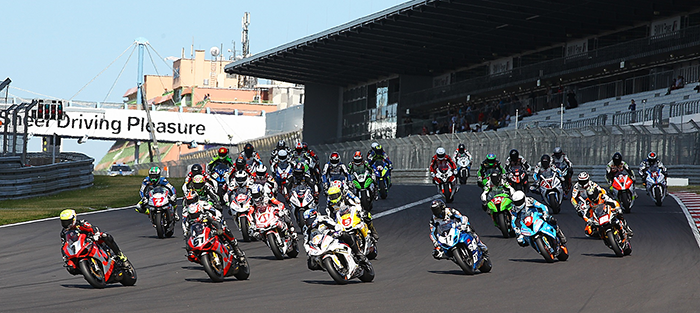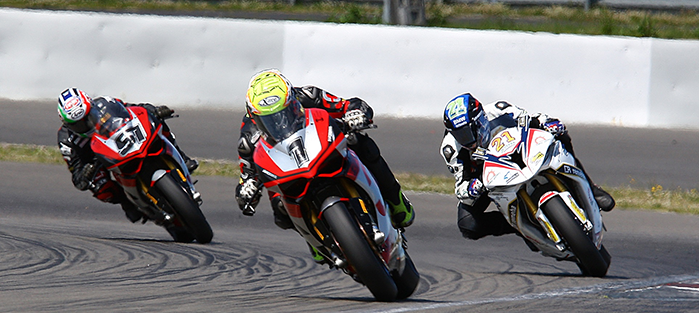- The Company
- Lechrain Technology Park
- Career
- Contact
- News
- 3c-Carbon Composite Company
- 3c-Medical Intelligence
- 3c-Swiss AG
- Horex
- 3c-American Motorcycles
- 3c-Design
- 3c-Racing-Team
- 3c-Driving Academy
- 3C-Carbon Car Concept
- DEEN
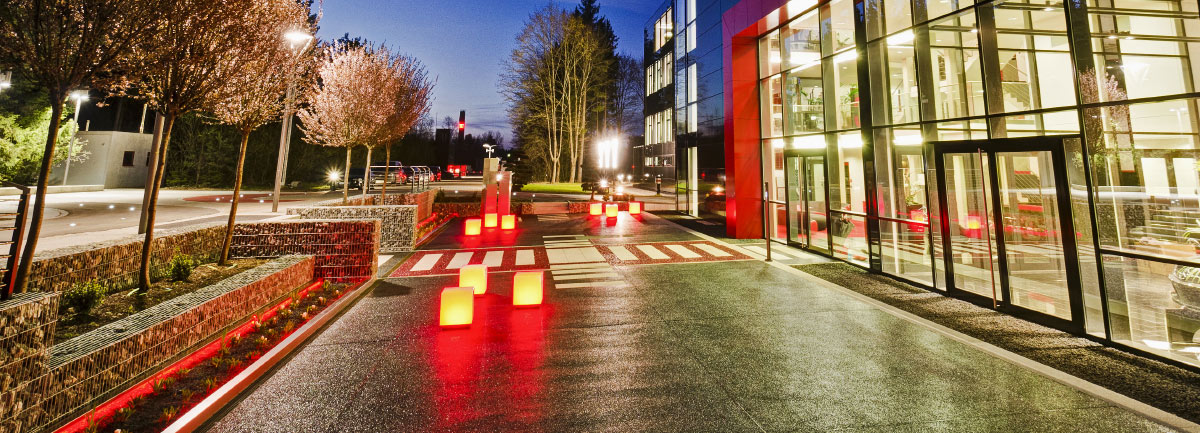

Together with Mayor Mathias Neuner and municipal architect Birgit Weber, CEO Karsten Jerschke presented the new street sign, which has more than a symbolic meaning for him. “The address not only reflects 3C-Carbon’s leading position as a manufacturer of composite fibre materials, but will also bring an end to confusion.” Previously, instead of coming to “Lechrainstraße”, suppliers and customers continually ended up at similar sounding streets in Landsberg.
The renaming also demonstrates how 3C-Carbon AG is continuing on its course of expansion. In future, it is not only the production and research facilities that are to be significantly expanded once again on the site of the former Lechrainkaserne barracks; sports facilities, company accommodation and a new prestigious research and development centre are also being planned – all of which will bear the “3C-Ring” address. “We aim to show that we are acknowledging the dynamic growth of this outstanding firm.”


In line with the basic orientation of the carbon manufacturer, all three designs provide for the close interconnection of high-tech, nature and residential. 3C-CEOKarsten Jerschke had already placed great emphasis on this when explaining the brief before the jury meeting. The aim of the development on the site of the former Lechrainkaserne barracks, he said, was to “make the outstanding landforms liveable for people, without disrupting the ecological balance.” In the north of the site, the company aims to construct a sustainable residential district with various types of buildings and floor plans, and ultimately to see a holistic campus develop with complementary infrastructure in the transitional area between the industrial buildings and the residential district.
Nineteen entries that tackled this exciting task were submitted (anonymously), and the local jury set about examining them intensely. The panel under the leadership of Nuremburg city planner Prof. Matthias Loebermann consisted of several specialist adjudicators - among them municipal architect Birgit Weber, Karsten Jerschke and Mayor Mathias Neuner as well as council members Berthold Lesch, Hans-Jürgen Schulmeister and Dr. Andreas Hartmann.
In an “open and friendly high-level discussion” lasting almost seven hours, after several closing rounds the jury decided on three concepts:
“A CLEARING IN THE WOODS”. As the title of the project suggests, a “clearing in the woods” is to be created. The design provides for a strictly circular form for the residential quarter with various building types and additional facilities for residents. The ring is intersected by two streets, but the site is otherwise car-free, with space for parking entirely underground.
The jury praised the fact that the design has been “kept to a minimum” and allows “plenty of room for nature and landscape”. The unique atmosphere can contribute to the feeling of community among residents, they believe. The jury members see a handicap, however, in the lack of possibilities for expansion and the limited development options; in addition, they believe the commercial viability of this solution is “questionable”.
“FOREST FIRST”. The design provides for four zones in the area: forest settlement, common area, industrial park and energy park. In the residential quarter, the plan provides for differentiated construction (of both apartments and individual homes), whilst the common area should function as a connective element between the residential area and the company complex (which is given organic roofs) as well as a space for the communal facilities and for the renaturation and expansion of the Wiesbach river.
With “Forest First”, the energy park, communal gardens and sports facilities are located to the west, whilst an adventure park completes the area to the south.
The jury was impressed by the transport connections by rail and B17, and rated the concept highly thanks to its overall “logical and nature-oriented allocation of the various purposes.”
LIVING WITH(IN) NATURE. The design was particularly interesting for the way it took a “classic” industrial site and incorporated alleys, pathways, squares and semi-public and semi-private spaces. This “intermediary” zone serves as a filter between living and working. The new settlement is complemented by reforestation efforts and offers an open pathway structure that is adapted to the various target groups on the site.
The work shows a unique interpretation of a company housing development, according to the jury’s report, and also lives up to its social responsibility. The panel did see a lack of detail on environmental standards and energy networks, however. The “appealing suggestion” to arrange the production spaces architecturally to the north was, they believed, “not possible” due to the production processes.
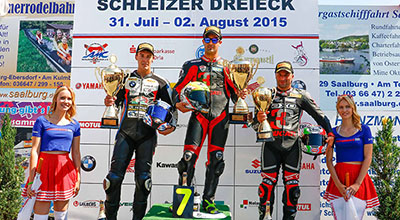
In the end, only Forés and the current overall leader Markus Reiterberger (BMW) were competing for victory in the two heats. During the first race, both riders challenged each other with tactical tricks virtually the whole time. Forés was in the lead over a greater distance. In the third lap from last, Reiterberger stormed ahead but was immediately pushed back into second place. On the last chicane, both riders were neck and neck. Forés crossed the line to turn into the bend and Reiterberger had to back off. And Forés had the better cards when accelerating away again anyway. With a slim lead of just 0.077 seconds, the defending champion was waved across the finishing line in first place. During the presentation ceremony, Xavi was very emotional and dedicated his triumph to his fellow countrymen and racing colleagues who had been killed in an accident at the Moto America two weeks earlier. "There were three of us on the motorbike today."
Forés took the lead early on in the second heat too. However, the 29-year-old was unable to counter after Reiterberger edged past him half way through and finished second after 18 laps. Lorenzo Lanzi finished third twice over the weekend. The points scored by the Panigale riders at the Schleizer Dreieck allowed Ducati to take the lead in the IDM Superbike Manufacturer's Championship. With 370 points, the Italian manufacturer is now ahead of BMW (266) and Yamaha (184). The next race will take place in Assen, the Netherlands this coming weekend (8/9 August 2015).
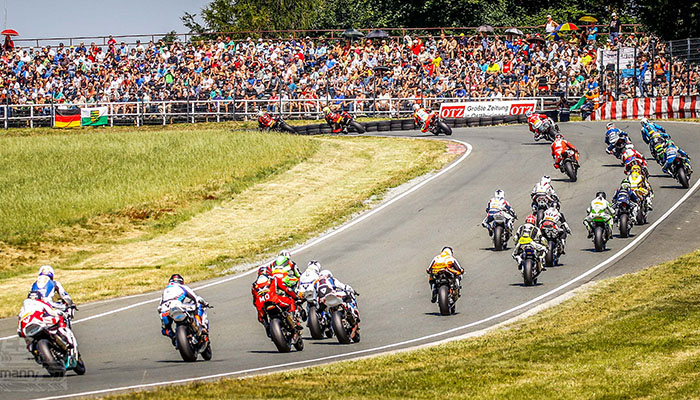
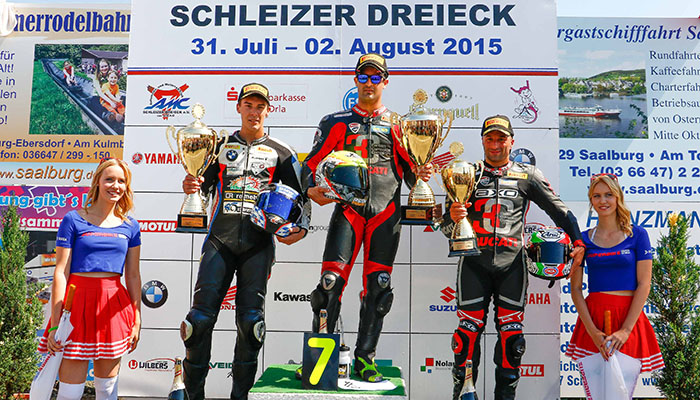
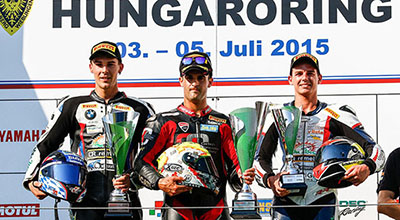
In the first heat, Forés was the first to take the corner, and he led the race for a long time, before Reiterberger, following numerous position changes, was successful at asserting himself. In the second heat, Forés, who once again took the lead, made sure this wouldn’t happen again. After 15 rounds, with a lead of 0.113 sec, he was waved aside as the victor. For the 29-year-old, and the entire 3C-Racing Team, this was an incredibly liberating feeling.
Xavi Forés: “The test on the Pannoniaring significantly contributed in further advancing the motorbikes. I had a tough battle with Markus Reiterberger but to take second place, like in the first heat, this is not my goal. In the second heat, I let Reiterberger pass to the middle, to study his line, and then I overtook him again. I knew that he would attack again in the last two rounds, but this time round, his tactic didn’t prove successful.”
Until the next race, the SUPERBIKE*IDM will be granting itself a little break. The race will be resumed on the Schleizer Dreieck, from 31 July to the 2nd of August. On the natural race track, the heats eleven and twelve, of a total of 16 races, will be held.
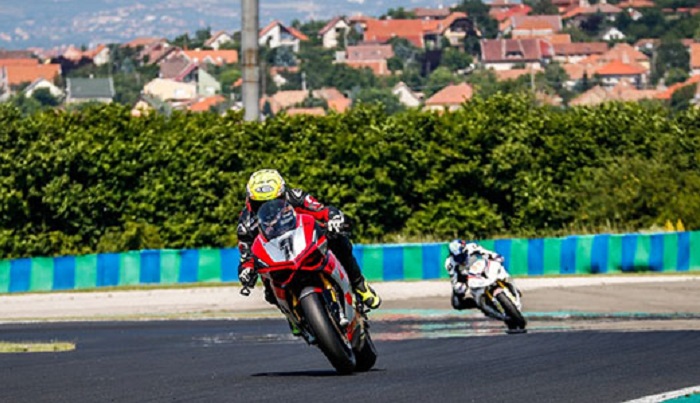
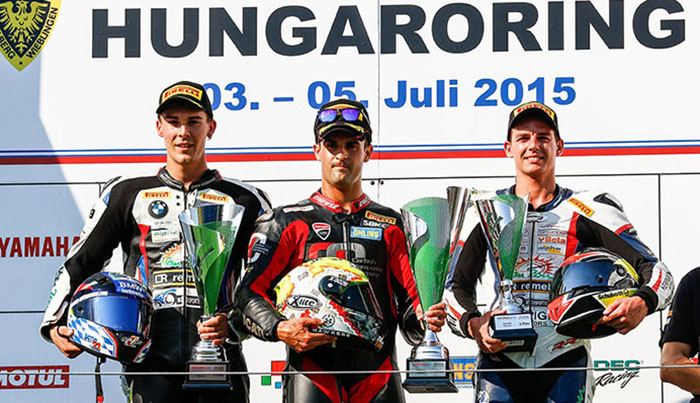
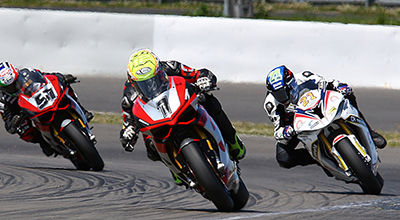
On Nürburgring, following numerous experiments with the material, the team took the decision during the previous weekend that the two drivers should race with different motorbikes. Forés used a hybrid version with the chassis of 2014, the electronics of 2015 and a Superbike-WM fuel tank. Lanzi started with all material from 2014. “The potential of the 2015 material would also have been very attractive, however, there has been no opportunity for thorough testing to date,” says the team boss Karsten Jerschke.
In the two races on the 3618 metre long Grand Prix stretch in the Eifel, Forés and Lorenzo came in at second and third place. However, the two 3C-Racing Team drivers had never before come closer to the championship leader, Markus Reiterberger. Forés was leading the second race of the day for five rounds, before Reiterberger launched a successful attack in the curve at the end of the home stretch.
After 18 rounds, merely 1.7 seconds separated the Spaniard from the winner. At the end, Forés still tried to regain the top position, yet he was hindered at this by drivers he had lapped.
At the Hungaroring in Hungary, the SUPERBIKE*IDM starts the second half of the season from the 3rd to the 5th of July 2015. Until then, the 3C-Racing Team will come to a final conclusion regarding the material to be used and compare all approaches with the 2015 components. “We will do everything possible to turn the tables. Winning the championship title remains our goal. The final result will only be clear in September, with the final in Hockenheim.”
